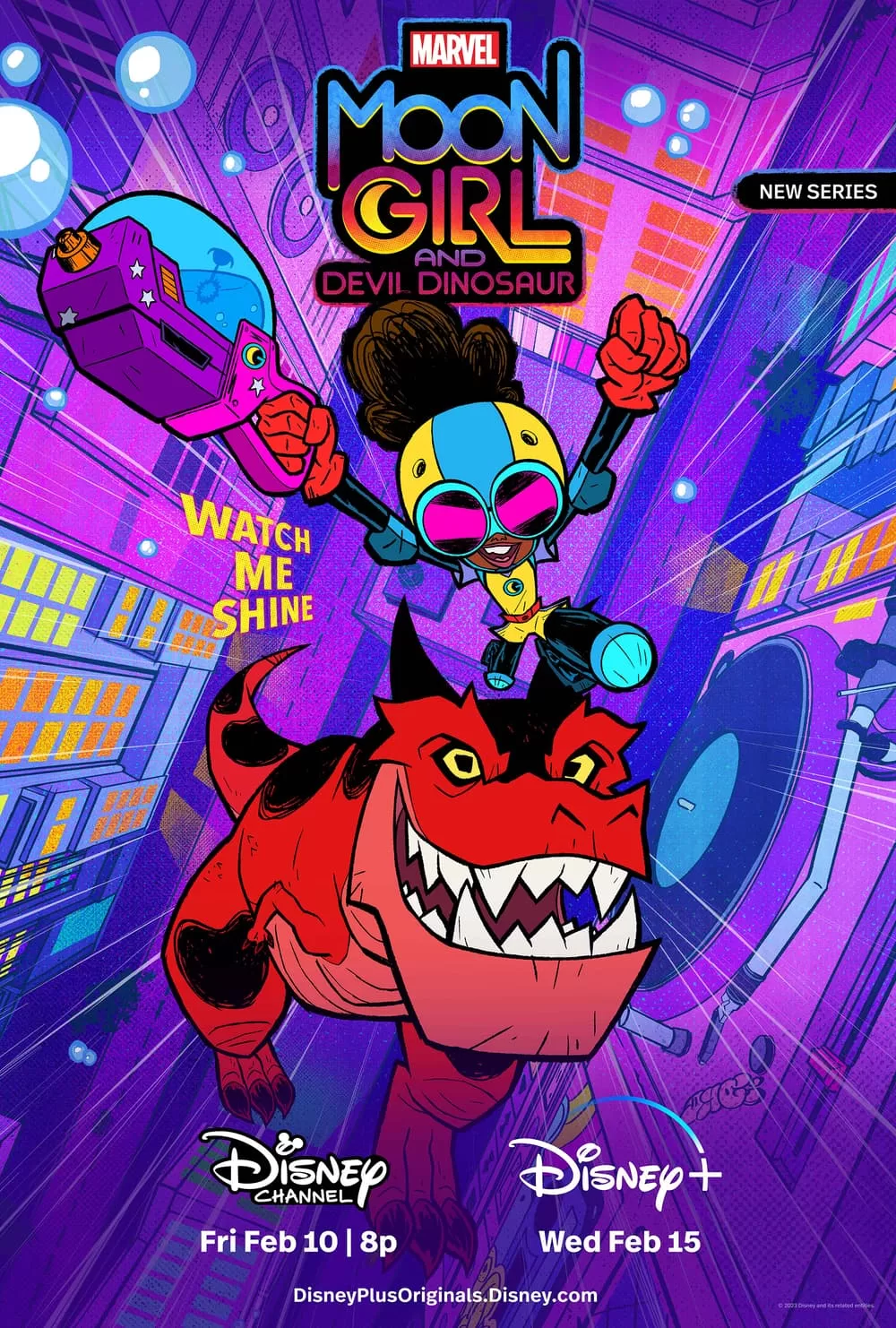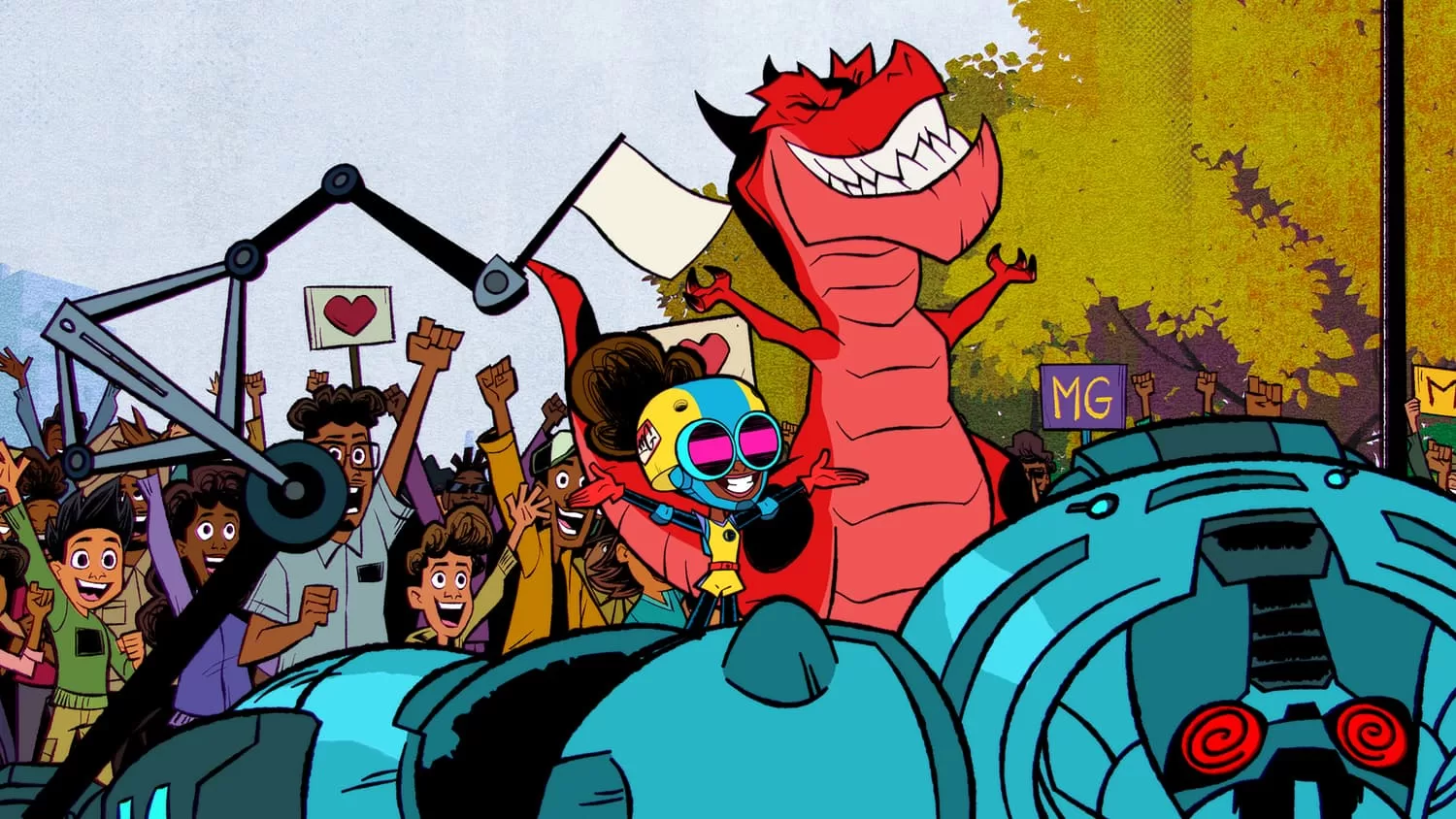Moon Girl and Devil Dinosaur is what you get when you take the groundbreaking aesthetics of Into The Spider-Verse plus the cutesy caption cutaways of Ms. Marvel, and then focused it in on adventures with an adorable puppy-like T-Rex. It’s a tale focused in on the rise of a young black girl superhero, herself a master at science, who’s helping her community out of the goodness of her heart… all while juggling school, friendships, and most importantly: family.
Moon Girl and Devil Dinosaur releases on February 10th on the Disney channel and then on February 15th for Disney Plus. The pilot will be an hour-long spectacle that introduces the characters’ origins and their area of the city in the lower East side. Having seen the first few episodes, our early thoughts are that the show is perfect for kids, is both incredibly funny and well-voiced, and has great themes of representation, with a surprisingly powerful message in episode 5 that makes a strong social commentary about hairstyles and hair loss, regarding black women in culture.
The Workprint was able to attend the MoonGirl and Devil Dinosaur press junket with a series of journalists and the show’s voice cast and creative teams. In attendance, included executive producers Laurence Fishburne and Steve Loter along with the series protagonists Diamond White as Lunella Lafayette and Fred Tatasciore as Devil Dinosaur.
Here are seven things we took away from the press conference, edited and combined in an abridged version for the sake of clarity.

1. How did you guys decide on the design for the show
to make sure it not only contributed to the action, but also, the culture that’s being represented?
Steve Loter: Well, I think that we wanted to make sure that we were doing something unique. “Spider-Verse” was a huge inspiration for us. It really kinda blew the doors wide open to do superhero animation that looked really specialized and unique. Laurence and I connected early, and we kinda talked about the vision of the show and what it should look like. Laurence is a huge comic book fan, so we used that as kind of a springboard for the visual styling, particularly the line work on the characters and the overall look of the show.
Laurence Fishburne: Yeah, we had a lot of conversations about backgrounds and about the environment, the color palette, and all of these kinda textures. Like you guys talked about the graffiti as one of the elements in our backgrounds and textures for New York and the Lower East Side.
Laurence Fishburne: We are people who really, really love animation from, you know, the very beginning of our lives. It’s just a joy for us to be creating this kind of show which, as Diamond said, is a show like we’ve never seen before.
2. How is Moon Girl and Devil Dinosaur different in terms of making an animated product?
Lawrence Fishburne: Well, it takes a lot longer. And, uh, we aren’t really, um…connected to the MCU, officially. Our show is really a family show. So, you know, maybe we’re not gonna save the world, but we are gonna save the Lower East Side.
Laurence Fishburne: Animation’s come a long way. I mean, if you consider just anime alone, right? Or you know, stop motion? Obviously what we’re doing is another step in the evolution of animation. Steve referenced the Spider-Verse. There’s another one (Spider-Verse) coming that looks…even wilder than the first one, so…
Steve Loter: Yeah, it’s a type of thing where it does feel like animation is for everybody and we wanted to make sure that this show was four quadrant. That’s an industry term which basically means it’s for everybody. It’s for parents, and kids, and grownup kids that may not have kids. It was really important for us to make sure that this show got everyone’s attention and everyone enjoyed it, for sure.
3. Diamond, how much of yourself do you see in Lunella Lafayette, AKA Moon Girl, and what does it mean to be a part of a show that’s so powerfully progressive?
Diamond White: (I see) A lot of myself. I grew up being African American and when I was 13—actually, not when I was 13. When I was seven, all I wanted was a character like this to come to life. So it’s cool to have someone of my skin tone and of my hair texture really be there. The representation is…it means a lot to me.
Diamond White: We made history being Marvel’s first teenage Black girl superhero. So it’s important to see that kind of representation. It’s a show that I needed growing up and I feel like it really does make a difference. Like the show says, one girl can make a difference. This show is going to make a difference in a lot of people’s lives so I’m just excited to be a part of it.

4. Can you talk about this specific version of New York in Moon Girl and Devil Dinosaur?
Steve Loter: Absolutely, yeah. I grew up in New York, uh, in the 80s and 90s in that zone. And I was there kinda at the beginning of graffiti art, a New York prior to gentrification, so I was there at kind of the perfect time where creativity, imagination, music, art, poetry, and books was still very vibrant and alive in New York. I wanted to make sure that we could capture that in the show. ‘Cause I’ve seen New York, um, misrepresented in a lot of animated properties, so I had to make sure it was accurate. So we relied on a lot of New York kinda artistic benchmarks—the Andy Warhol silk screening process, um, Basquiat graffiti art, street art murals—to kind of find the flavor of New York we wanted to capture. I knew that I had to get it right ’cause if I didn’t, I couldn’t go back to New York. They wouldn’t allow me back in. So I had to make sure I did it right.
5. Aftershock (the pilot’s antagonist) is such a terrifying embodiment of gentrification as a villain. I’m wondering if you can talk about her development and why it was important that this was the first villain in the TV show?
Steve Loter: Being that Aftershock is the first villain in the series, the first real formidable villain that Lunella faces as Moon Girl, we really did wanna encapsulate a lot about what the mission statement was of the series. That one girl makes a difference storyline which is super important. So to have Aftershock coming into the Lower East Side sapping it of its- its energy—a lot of, you know, proverbial notions there—basically it’s a statement about gentrification. It’s a statement about losing community and neighborhood and connection. So yeah, it was really important for Aftershock to kinda be the conduit—no pun intended—for that kind of story. Um, but yeah, totally intentional. And it’s the daughter of Electro, so that’s always fun, too.

6. Talking about representation, is nerd the new cool?
Laurence Fishburne: Yeah, well, I- I’ve always thought that, um, it was smart to be cool. No. I’m sorry. I always thought it was cool to be smart.
Gary Anthony Williams: I like both. Go back to that other one.
Laurence Fishburne: Yeah. And it doesn’t matter what your gender, what your color, what your faith, uh, what country you live in. I’ve always thought that it was really, really cool to be smart. Um, and I think it’s just important for us to have this kind of representation because you can’t be what you can’t see. So if more young girls of color get to see an experience of a person like Lunella, then perhaps, they won’t be afraid to show their intelligence and to lead with their intelligence, you know? I think it’s just a good thing to do.
7. What was your initial reaction to “Moon Girl and Devil Dinosaur” being renewed for a second season even before the show premiered on Disney Channel?
Laurence Fishburne: (Cheers.)
Steve Loter: Basically that, yeah. Yeah I mean, it was- it was—what a great feeling because we knew we had more stories to tell. Um, it was kinda—as- as Season 1 goes on, the story gets more serialized. (00:23:30) You- you see kind of an antagonist kind of rise up from the background. Um, and we just felt like there was so much story to tell. I mean, we’re hoping for past Season 2 because we feel like Lunella Lafayette has a lot more stories to tell.
Checkout Moon Girl and Devil Dinosaur February 10th on Disney Channel and February 15th on Disney+
Thank you again to the teams at Disney+ and Metro for the opportunity.
Moon Girl and Devil Dinosaur’s animation was provided by Flying Bark Productions. Season one features voice acting from Alfre Woodard as Lunella’s grandmother, Mimi; Libe Barer as Lunella’s best friend and manager, Casey; Sasheer Zamata as Lunella’s mom, Adria; Jermaine Fowler as Lunella’s dad, James Jr.; Gary Anthony Williams as Lunella’s grandfather, Pops.
Season one will also feature guest voice appearances by Alison Brie, Andy Cohen, Daveed Diggs, Maya Hawke, Jennifer Hudson, Method Man, Cobie Smulders, Wesley Snipes and more.
For more info on the character checkout Marvel’s Moon Girl 101 summary below.
